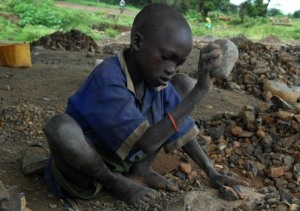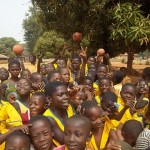 OUAGADOUGOU, 30 August 2012 (IRIN) – A boom in Burkina Faso’s gold mining over the past three years has made the country one of Africa’s leading producers, but it is also luring children – some as young as six – out of school.
OUAGADOUGOU, 30 August 2012 (IRIN) – A boom in Burkina Faso’s gold mining over the past three years has made the country one of Africa’s leading producers, but it is also luring children – some as young as six – out of school.
The exact number of children abandoning schools nationally for the mines is still unclear, but many schoolchildren are known to work mainly in artisanal mines where they crush stones, sieve dust, transport water and cook. Others go to the mines during school off-days on Thursdays and Saturdays, said Moussa Ouedraogo, the Ministry for National Education and Literacy director for the country’s northern region.
“This does not mean they have given up school, but it is an indication that they could end up abandoning it altogether under the influence of parents and others who have made money there,” Ouedraogo told IRIN. He said 900 children skipped exams in the region this year and 3,300 others work in the mines during school off-days.
“We are sensitizing parents to curb the trend,” he said, but admitted that rewarding parents and children with bicycles, books and cash for abandoning the mines was having little effect.
According to the Ministry of Finance, gold has become the top export commodity. In 2011, it earned Burkina Faso 127 billion CFA (US$247 million). Between 2007 and 2011, it brought in 440 billion CFA, accounting for 64.7 percent of all exports and 8 percent of GDP. Production rose from 23 tons in 2010 to 32 tons in 2011. Gold mines are spread across the country’s northern, western, southwestern and central regions.
The government in 2003 revised its mining laws to encourage investors. Between 2007 and 2011 seven industrial mining sites opened in the West African country, where cotton was the main export cash crop.
Some 800 traditional mining sites, where most children work, have also opened, according to Terre Des Hommes, an international NGO promoting children’s rights and which is working with Burkina Faso’s Education Ministry to curb the negative effects the mining boom is having on education.
“This is an opportunity in the village and I don’t want to miss it. If I make money I will not need to go to the capital [Ouagadougou] to look for work if I fail in school,” said 13-year-old Ousséni Sawadogo. He is paid one-third of what he produces, with the mine owner taking the rest. In the past four months, Ousséni said he has earned some about $400, but that his friends have earned more.
Patchy school attendance
Primary school enrolment in the country is 57.8 percent, but only 33.9 percent of pupils complete school nationally, and just 24 percent in the rural areas. Children as young as six and older ones up to 17 can be found working at the mines, the government’s National Institute for Statistics and Democracy found in a recent study.
“We need to hold national debates on the issue because in five years, we won’t have schools in some areas of the country,” said Hassane Sankara of the Cadre de Concertation des ONG pour l’education de Base, a coalition of local NGOs working for the improvement of primary education and enrolment.
Sankara expressed concern that all the investment made in recent years to boost school attendance could be lost. In 2001, the government launched a 62-billion CFA ($118 million) project aiming to increase to 70 percent the number of children enrolled in primary school by 2010, and 100 percent by 2015.
“It is a total failure of the national policy because [mining] is taking children out of schools, empties learning centres and only old people remain in the villages,” said Sankara, whose own cousin abandoned Advanced Level secondary school for a mining site in Kalsaka in the north.
“The mining impact goes beyond the education sector,” Education Minister Koumba Boly told IRIN, voicing worry that the country’s overall development could be undermined if education is badly affected. The minister said a decree will be issued when schools re-open in mid-September banning all children from mining sites.
In Burkina Faso’s central Pousguin region, the population has surged to 35,000 from 10,000 in one month after a new gold mine was discovered there recently, said Herman Zoungrana of Terre Des Hommes.
“We are witnessing the birth of new villages and the new settlers come along with their children,” Zoungrana said. He explained that it is difficult to completely take children out of the mines because they often migrate with their families whenever new mining sites are discovered.
“You can take 100 children back to school today and the next day they have moved to another place because there is a new site,” he said. “The mining sites are the only [economic] opportunity for these people who move there with their families. More and more mining sites are becoming villages on their own. And even if the children do not work, they live there.”
Abdoul Moumouni Kaboré, 17, said many children work at the mines to support their families.
“I came for holidays and I have never gone back to Ouagadougou because around us a lot of boys are caring for their families with the money they are making from the site,” said Kaboré, who has been working at a mine in Pousguin for the last two months. “You need to work hard and wait for your luck. I can’t go back home until I get something because people will laugh at me.”
Poverty
According to Moussa Ouedraogo, the regional director of education in the north of the country, the Education Ministry this year distributed food to schools in the region known for its poor harvests to prevent children from joining the mining sites.
“But we were able to cover only part of the school year with food distribution,” he said. Poverty and hardship relegate the importance of education and many people have taken up mining for their economic survival.
Terre Des Hommes’s Zoungrana said they have also distributed cereals and other foods to school canteens and to some families to dissuade parents from sending children to mine.
“We also try to make school a pleasant place with games and sports,” Zoungrana added.
Mining companies also need to act
The Ministry of Education says the strategy to stem school dropouts depends on the local administrators such as mayors, but Zoungrana said the problem cannot be resolved at the local level alone.
“The communes [local authorities] are committed, but there is no government legislation to back their actions so that the mining companies can also be compelled to contribute financially to strengthen their actions.”
IRIN Humanitarian News and Analysis
Give Back Africa Foundation is commited to providing children in underprivileged communities in Africa with the necessary resources to help them advance their academic achievements and realize their personal potential. You can make a difference today by keeping a child in school. Click Here to see how you can help



